1 Man, 4 Days, 8 Whisky Distilleries
Author: Guest Blogger
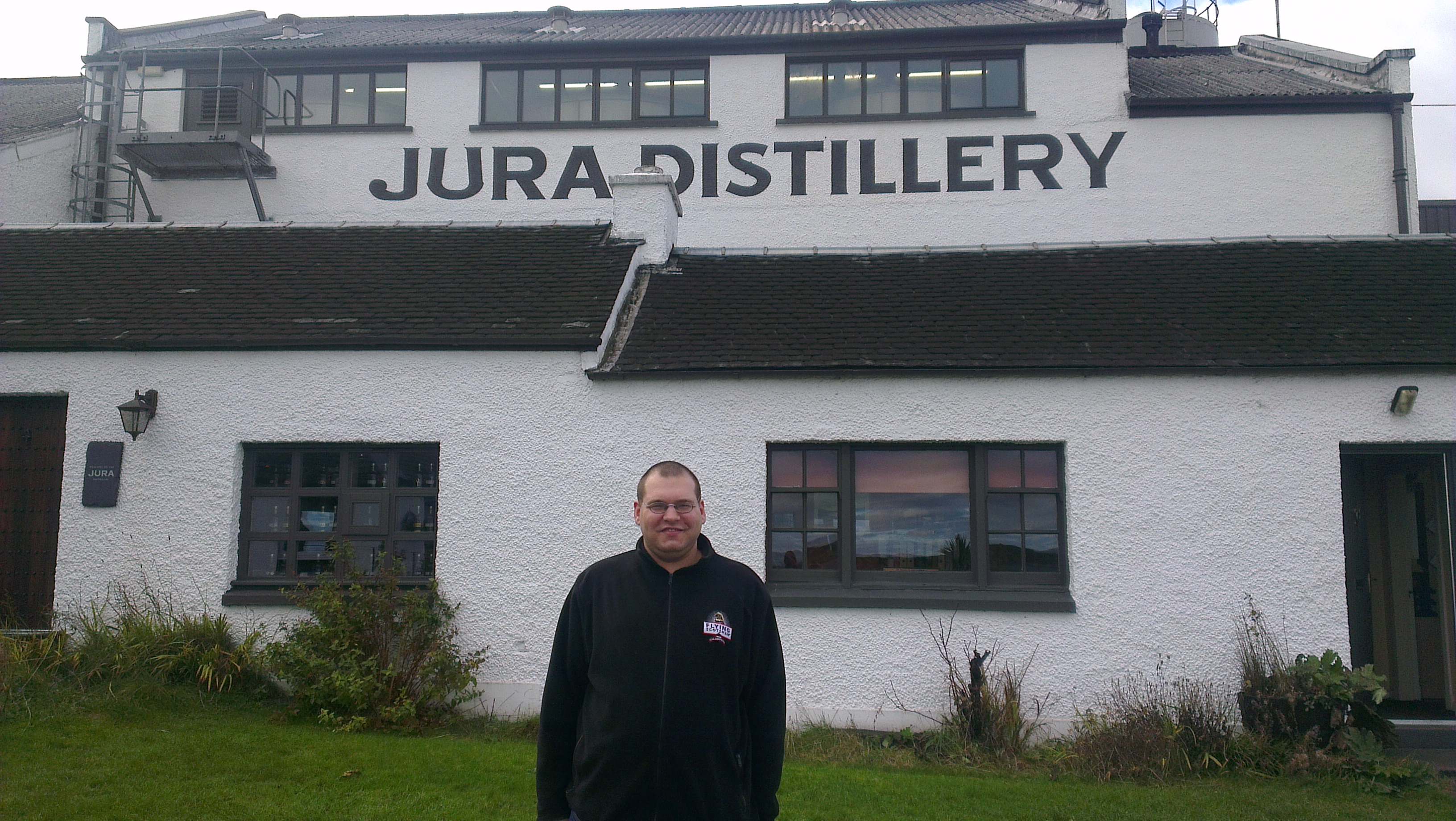 After eight years in the alcohol trade, many of them involved with Whisky (having been a part of the Berrys’ stand at almost every UK festival for the last two years), at the end of October, I finally decided it was time to significantly increase the count of distilleries I have visited from a paltry two.
After eight years in the alcohol trade, many of them involved with Whisky (having been a part of the Berrys’ stand at almost every UK festival for the last two years), at the end of October, I finally decided it was time to significantly increase the count of distilleries I have visited from a paltry two.
Seeing others’ shock that I had never yet been to the famed Whisky isle of Islay, I made this the focal point of my recent trip.
I decided to take the “slow route” and visit Arran and Campbeltown on the way, which meant I could also take advantage of Calmac’s “rover-type” Island Hopscotch ticket – a discounted ticket that allows a round trip using the Ardrossan-Arran, Arran-Kintyre and Kintyre-Islay and return routes.
Having unfortunately endured a much delayed flight due to a very foggy Gatwick, I arrived into Glasgow Airport well after midnight and with a few hours’ kip, I picked up the little 107 that was to be my companion for the 350 miles driving over the next 4 days.
The first stop was Ardrossan Harbour to catch my first ferry of the trip across the Firth of Clyde to the Isle of Arran. A beautiful island, which also happens to be home to one of the best driving roads in the British Isles – the winding A841 between Sannox and Lochranza, situated in the middle of a glen. In fact, Arran is actually known as “Scotland in Miniature”, due to the small island having mountains, lowlands, glens, lochs and royal castles.
Once home to many illicit stills up until the mid-19th Century, whose production was widely regarded as the best in the whole of Scotland, there was a 150 year gap in Whisky production on the island until the Isle of Arran distillery opened in 1995.
Isle of Arran
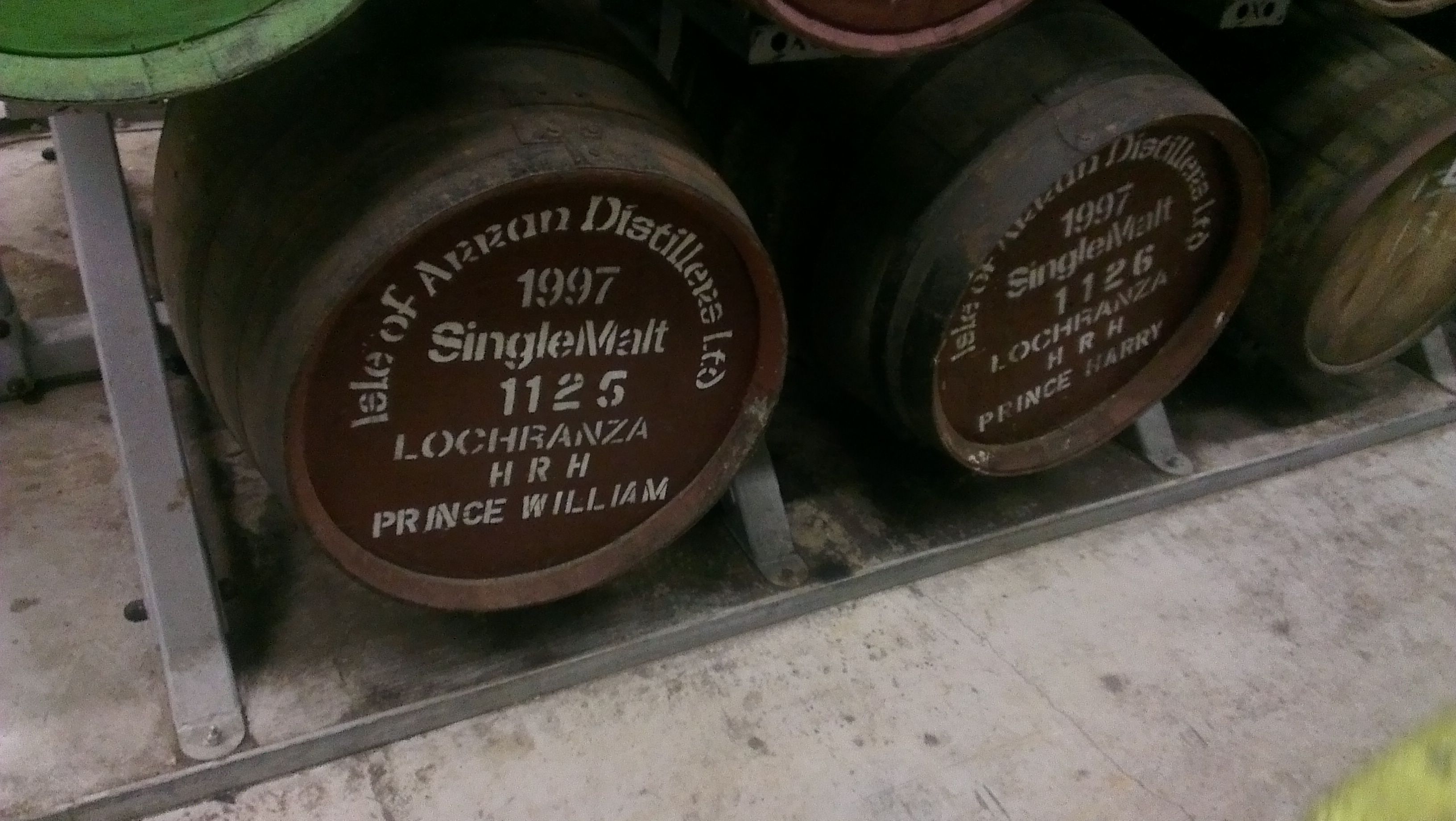
Opened in 1995, the distillery’s aim was to produce a high quality unpeated Island malt. Campbell Laing, the head tour guide, showed me round the purpose built visitor’s centre, before James MacTaggart, the distillery manager, a man with over 30 years experience previously with Bowmore showed me a few places you don’t normally get to see on the public tour, namely the warehouses (including casks of 1997 set aside for Princes William and Harry) and the water source, a stream which flows directly from Loch na Davie in the hills above the distillery
– tests show this is the purest water supply in the whole of Scotland
Arran 14 Years Old £46.20 – A step up from the 10 year old (which consistently wins awards amongst whiskies from all around Scotland of the same age), this is a whisky which clearly exudes the fact that the majority of the whisky was aged in first fill Bourbon casks. A nose and palate of toffee apples is in abundance, with a lovely spicy finish and a hint of a salty tang.
After a quick bite to eat in the on site Café at the distillery (highly recommended!) it was off to catch the second ferry of the day over to the Kintyre Peninsula, home to the town that used to be “the Whisky capital of the world”, Campbeltown.
Whisky distilleries there have fallen sharply from the 34 in its heyday, down to just 3 today (and one of those, Glengyle, is currently only producing for 1 month every year!) As with certain areas of the north of England, the decline is noticeable – with no major industry left, unemployment is high (the highest in Scotland with a claimed figure of 13 applicants for every job) and the area sadly has a rather run-down feeling about it.
Springbank, Campbeltown
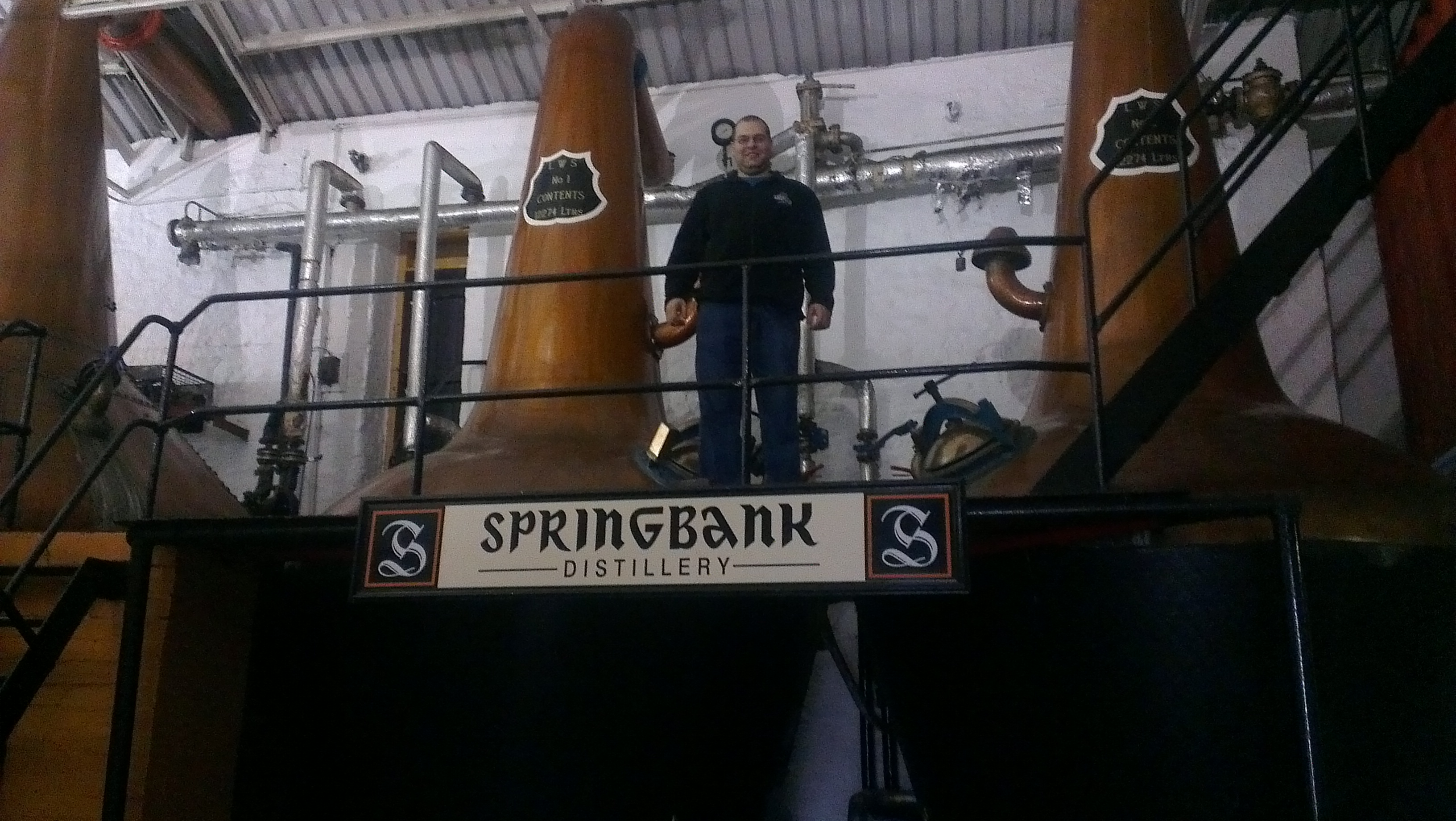
Due to the start of the low season, I ended up being the only participant (something I was to experience a few times during my trip), and was therefore treated to a personal tour by head tour guide, Jim. Springbank are one of only six distilleries left in Scotland that malt barley themselves on site. I took full advantage of this and was shown some barley being steeped and even got to turn the malt myself.
Glengyle, Campbeltown
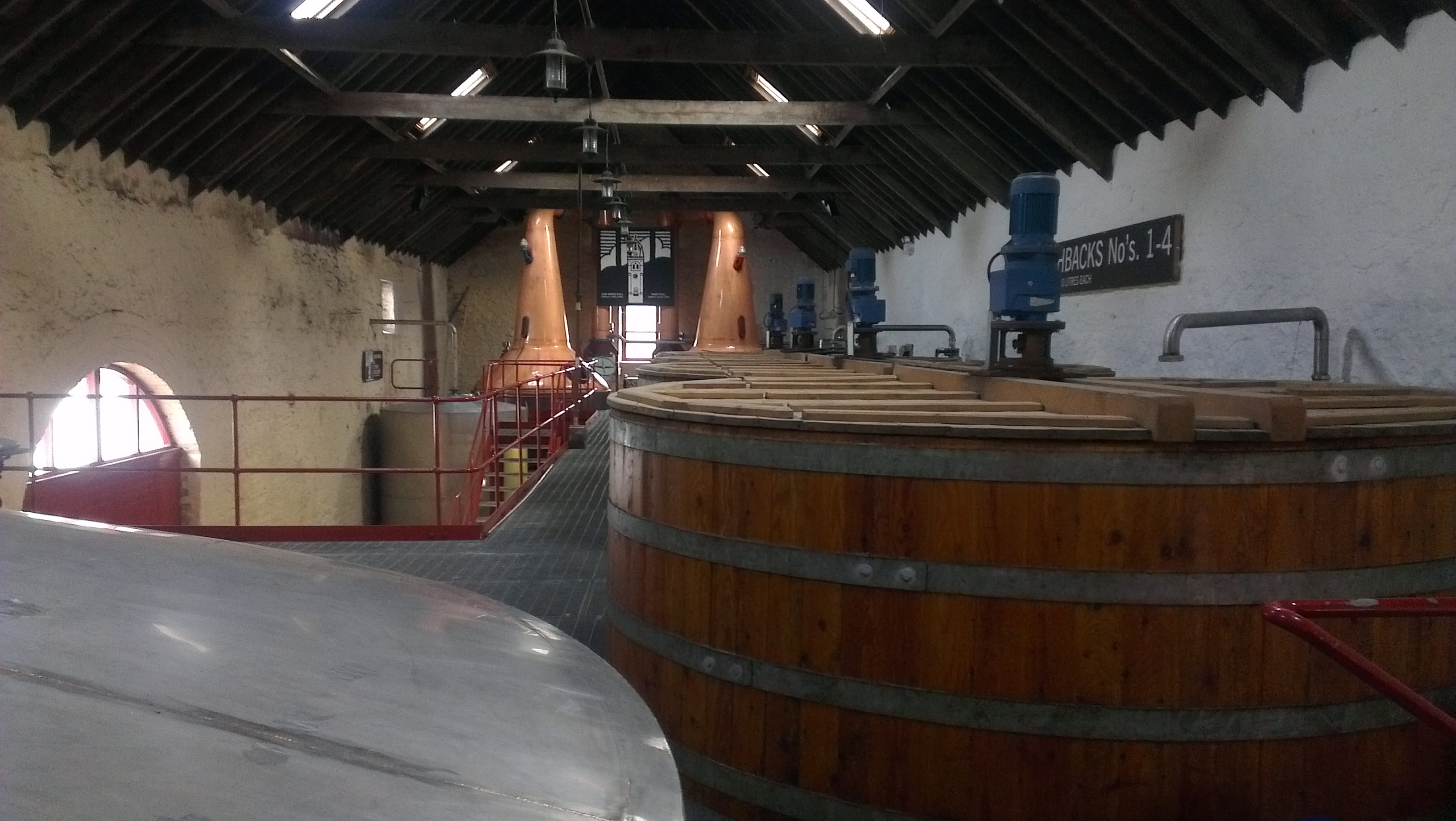
Less than half a mile from Springbank is their sister-distillery, Glengyle. Reopened in 2004, only one room of the distillery is currently used and only for one month every year. The six men who make the whisky at Springbank move over to Glengyle to action the production there. The barley is malted and milled at Springbank and then taken over to Glengyle where the process starts in the mash tun. The whisky produced here will be called Kilkerran (due to there already being a Blended Malt called Glengyle). There is a limited edition release each year called “Work in Progress”, until 2016, when the first addition to the ongoing range, the 12 year old, will be launched. Hopefully production can be increased at this point to make full use of the distillery.
Kilkerran, Work in Progress, 8 Year Old – Being a driver, and only being able to have one small nosing sample in Campbeltown, I decided to choose something I wouldn’t normally try, something we don’t stock and to take the opportunity to see how Kilkerran was progressing. The nose is one of toffee and vanilla, which follows through on the palate. A hint of spice and bitter chocolate are present too. A delicious dram, the distillery is showing great potential, which makes me quite excited for the first proper release in 4 years’ time!
Then it was time to head up the A83 to catch the ferry to Islay, the original destination of my trip. As most of the distilleries on the island are situated next to the shore, I could see them on the way into port. Coming into Port Askaig the two in question on this occasion were Bunnahabhain and Caol Ila. My first stop was to be the latter of these.
Caol Ila, Islay
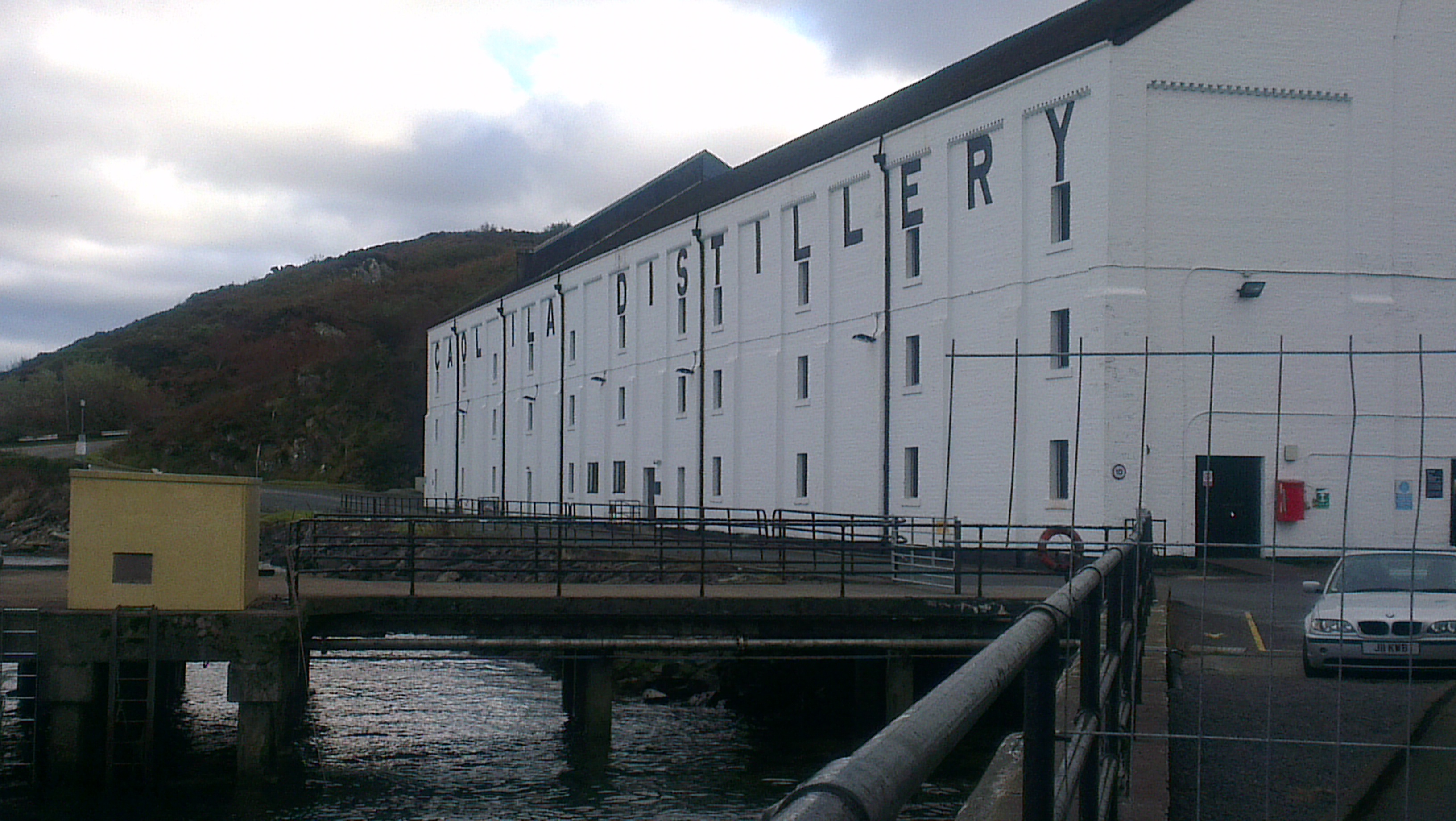
Upon arrival, I have to say it wasn’t quite what I was expecting. Rebuilt in the 1970s, it looks more like a school Science block than a distillery and has more of a factory feel than any other in Scotland.
Through one of the windows, I caught a sight of the large stills, each one of which holds 21000 litres (compared to 2000 for Kilchoman or even the 12000 at Springbank) and the distillery gets through a massive 324 tonnes of malt every week!
The reason for this is that only around 5% of the distillery’s production goes into Caol Ila. The rest is used for producing the peated malt that forms the backbone of Johnnie Walker and Bell’s. This was a useful visit, not just to see the size of the distillery, but part of the reason for my trip was to see the differences between the distilleries. After all, the same three ingredients are used everywhere (water, barley and yeast) and it is the small differences in a variety of places, for example the fermentation time, still shape, still size and barrels used in the ageing process, that produce the various tastes and styles of the resultant whiskies.
One interesting fact I learnt here, is that due to the amount of spirit produced here, it is all sent via tanker to Edinburgh to be put into casks and stored. The warehouses at Caol Ila are all filled with Lagavulin!
Laphroaig, Islay
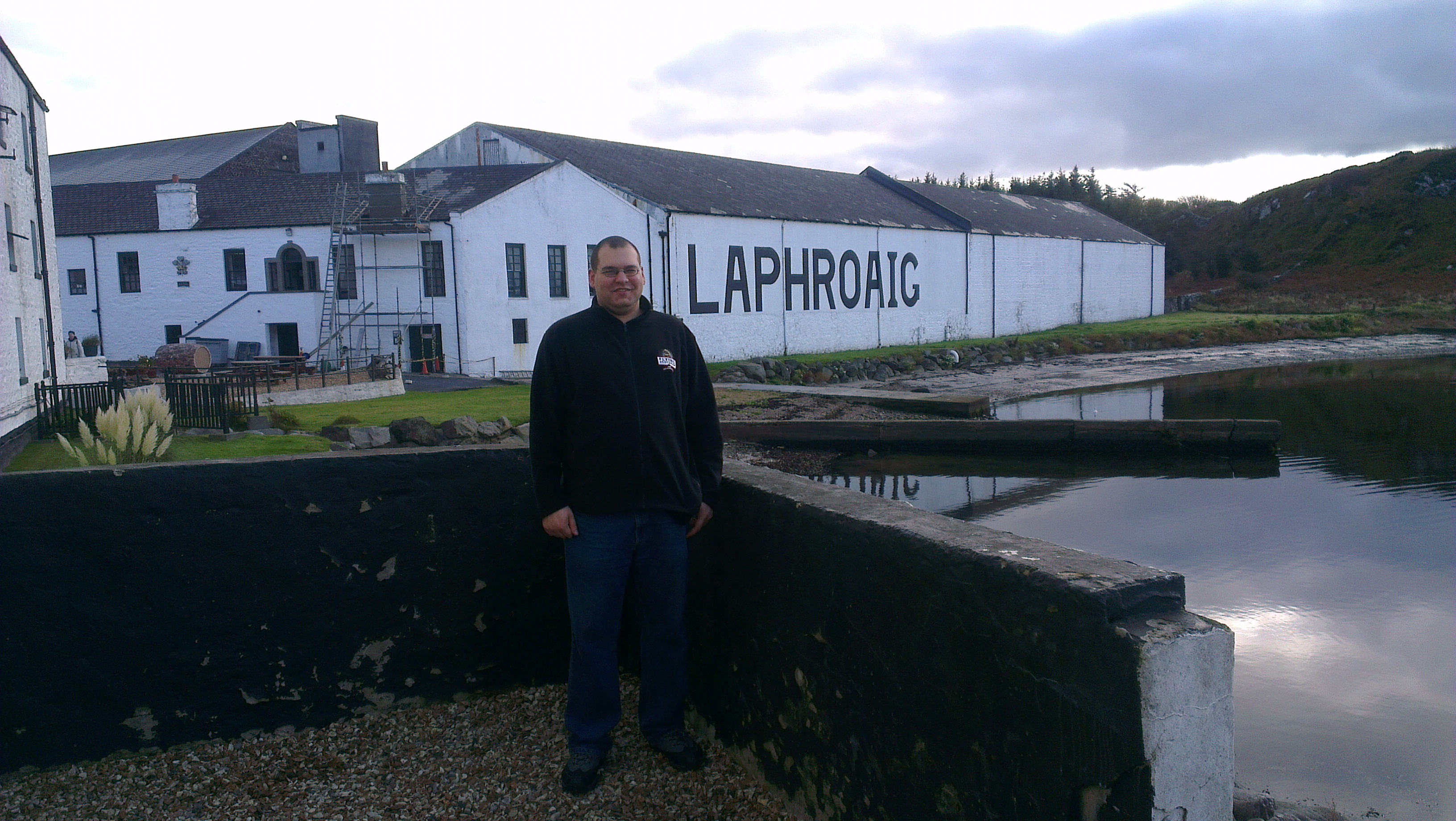
Named after the loch of the same name next to which the distillery lies, this is the most distinctive tasting malt in the world. Upon arrival, I found I was the only person on the tour once again, so was treated to a personal walk round by David, a veteran of 38 years’ experience at Laphroaig.
Laphroaig is another distillery to retain their own maltings, but due to the amount of barley needed, this is only enough for 10% of their needs. The highlights of the tour were seeing some barley being dried in the kiln (actually a large room that gets heated up) and getting “treated” to drinking the wash, a type of beer at 8% ABV before it gets distilled, both of which I was only to experience once on my trip.
As an aside, Laphroaig were the most “driver-friendly” of all the distilleries I visited, with drivers being given a miniature to take away with them, rather than being offered a dram to drink there and then.
Laphroaig Triple Wood £45.95 – My favourite Laphroaig used to be the Quarter Cask, until I tried this! Aged in Bourbon casks originally, a second maturation then takes place in small Quarter Casks, before being finished off in Sherry butts. The resultant spirit is complex, with notes of toffee and vanilla and, as one would expect from a Laphroaig, a high level of peat, but with a sweetness that cuts through it. Surprisingly more-ish for such a peated whisky.
After this, I decided to take a break from the peat and head to the neighbouring island – Jura. It’s only accessible by car from Islay via a 5 minute ferry crossing, and upon joining the queue for it, I was surprised to see a friend from the whisky trade in the car in front of me along with his new fiancée, having got engaged just the day before (I’m told the no.1 vaults at Bowmore are a great place to propose) – it really is a small world in the alcohol industry!
Jura is an island that was once home to 2000 people is now home to just 200 (and 5000 deer, so that’s 25 deer for every human). George Orwell spent the last three years of his life, including finishing Nineteen Eighty-Four here There is one village on Jura, Craighouse, which contains one shop, one pub/hotel and the Isle of Jura distillery and that’s about it. What really brought home the size of the island though, was their version of the “Yellow Pages”, just a 2 sided sheet of A4, with every resident and business of Jura listed!
Isle of Jura
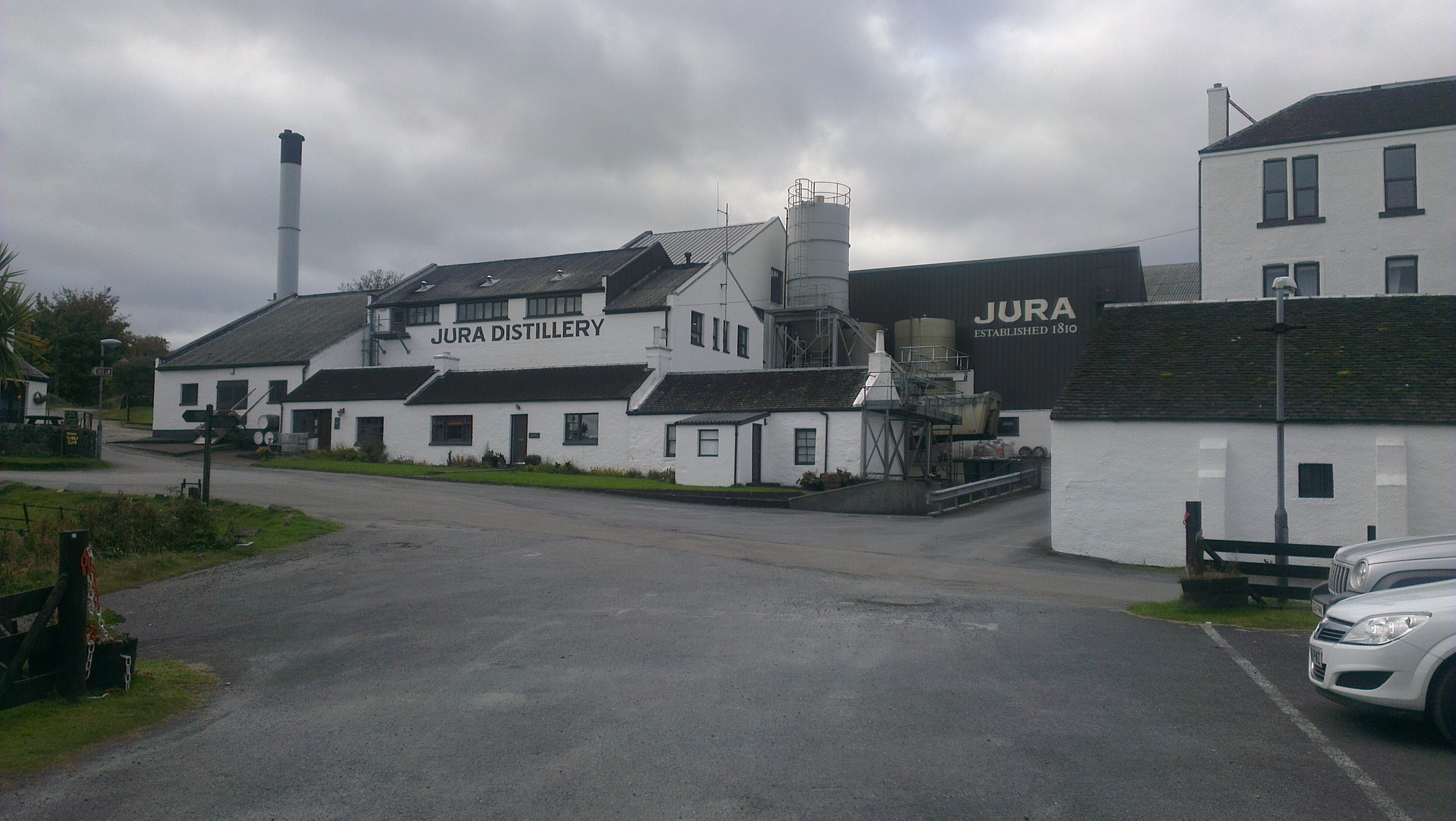
The 10 year old was actually the first whisky I ever enjoyed, so it holds a special place in my heart. The distillery was rebuilt in 1963 as the only Island distillery producing an unpeated malt, and only employs staff who reside on the island, such is the distillery’s importance to the local economy. Despite the distillery capacity being only a third of that at Caol Ila, the stills are actually bigger (the biggest in Scotland in fact) at 24000 litres. However this is not done to produce more spirit, but the larger stills allow the production of a much lighter style of whisky.
Having waved goodbye to my newly-engaged friends, I headed to catch the ferry back to Islay, which was a little rougher than the outbound crossing, possibly due to the tiny ship (it has room for just 8 car-sized vehicles) having a Luton van at each end!
Kilchoman, Islay
My final visit on Islay was its newest distillery, Kilchoman, a true farm distillery (indeed the building next to the distillery is used to house cows!). Established in 2005, everything is done on site, from growing a proportion of their barley on their farm (the only distillery on Islay to do so) right through to the bottling. The distillery has the fourth smallest capacity in Scotland, at just 120,000 litres (and only Edradour of those that are smaller is an established distillery).
Unfortunately the visit was a bit of a whistle-stop one, due to me only arriving shortly before they closed for the day, but I can highly recommend the on-site café, which offers a variety of homemade food and cakes!
Kilchoman 100% Islay £75.00 – This is the spirit produced from the barley which is grown on site. Only a 3 year old, the balance is incredible, with the peatiness matched by the creamy texture and notes of butterscotch ad sweet vanilla, all at a punch 50% ABV. I for one can’t wait to see what the future holds for this distillery, which has undoubtedly superb potential, based on what has been released so far.
Then it was time to say ‘Tioraidh’ to Islay and start the long journey home. With the ferry times not quite working in tandem with my flight time, I had a few hours to kill in Glasgow, so made a last visit of the trip to Auchentoschan, situated on the A82, just a few miles from the city centre.
Auchentoschan, Lowland
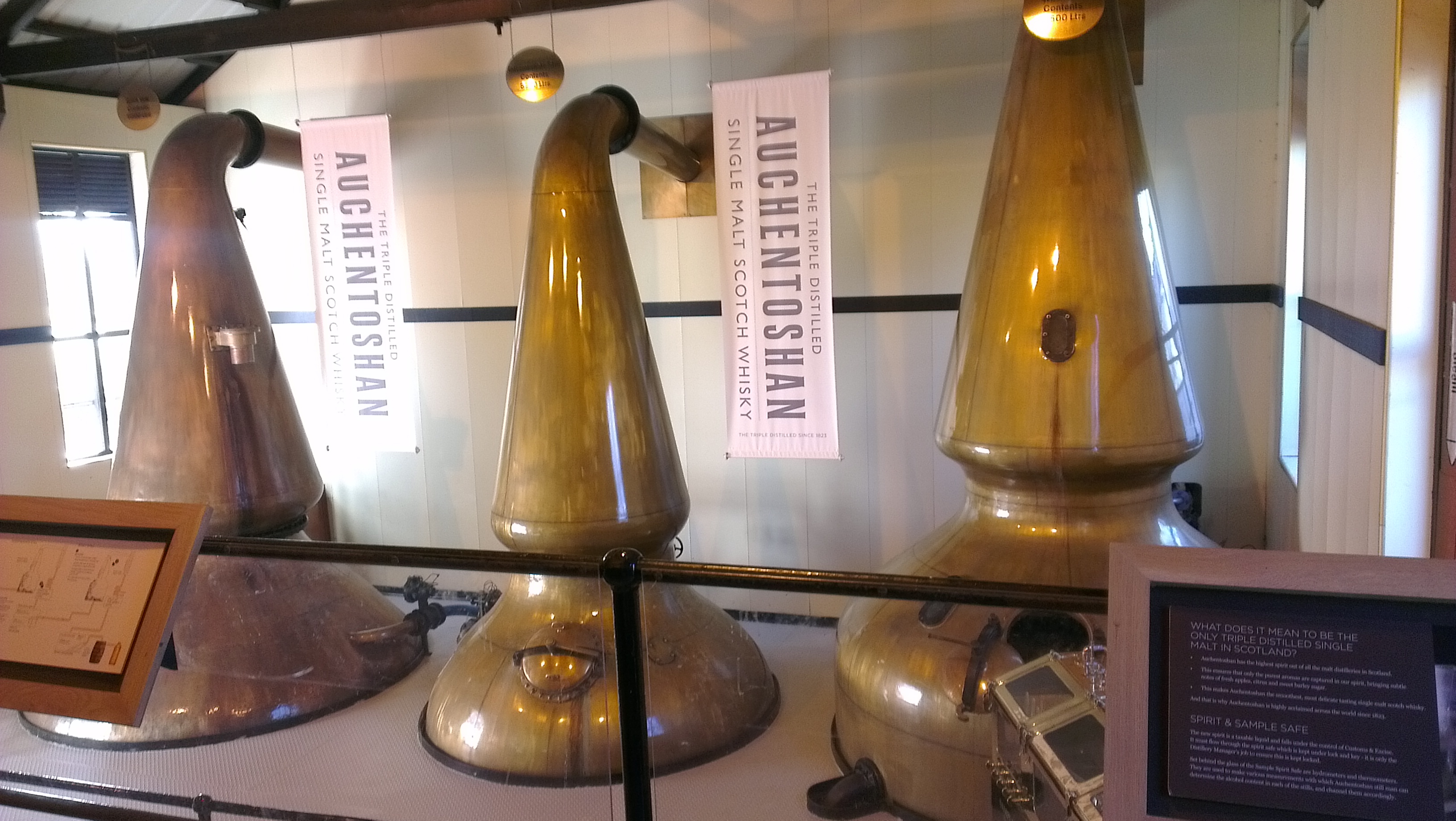
The only distillery left in Scotland where all the production is triple distilled (Springbank do too, but only for their ‘Hazelburn’ whiskies), the whiskies produced are of a much lighter style, in fact we in the trade call them “breakfast whiskies”. Production had stopped for the day when I arrived, so sadly I couldn’t see the three still system in operation.
Overall, it was very interesting to see the differences between the methods used at the various distilleries and also the difference in scale between the sizes of places such as Caol Ila and Kilchoman.
Even if you only have a passing interest in whisky, Islay is definitely a great place to visit. The friendliness of the inhabitants is something else, to give just one example, when you’re driving, it is customary to wave at every vehicle that you pass – so much so, I ended up adopting a new way to hold the steering wheel to make it easier to do so. The same is true on Jura, but this is more enforced, as there is only one road and it’s single track, so when you pass someone, one of you had had to stop to let the other through!
It’s also a great place to get away from the normalities of everyday life. Phone reception is so notoriously bad (you can go from full signal to none with just a half step to either side!) that you end up not using your phone or the internet – it’s the first time I’ve had a proper holiday away from emails in years! I’ll certainly go back, if not just to visit the other four distilleries I didn’t manage to fit in.
If you’re interested in matching Whisky (and other spirits) with Cheese (and other foods), I will be hosting masterclasses in our Basingstoke Shop on Saturday 1st December at 11.30am and 2.30pm, with a wide range of reduced spirits available in the shop on the day too!


